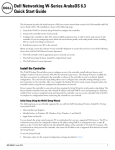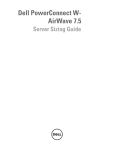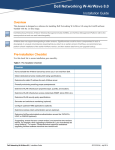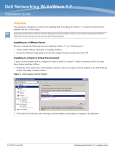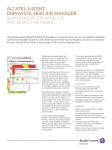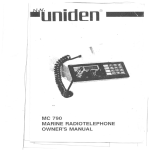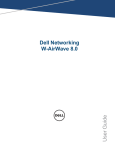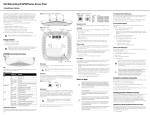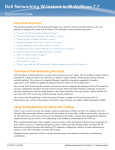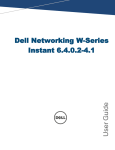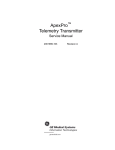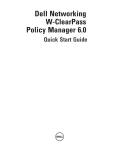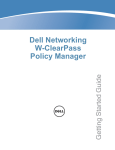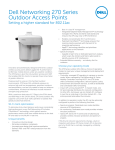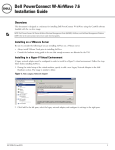Download Dell PowerConnect W-Airwave 8.0 Sizing Guide
Transcript
Server Sizing Guide Dell Networking W-AirWave 8.0 Copyright © 2014 Aruba Networks, Inc. Aruba Networks trademarks include , Aruba Networks®, Aruba ® Wireless Networks , the registered Aruba the Mobile Edge Company logo, and Aruba Mobility Management System®. Dell™, the DELL™ logo, and PowerConnect™ are trademarks of Dell Inc. All rights reserved. Specifications in this manual are subject to change without notice. Originated in the USA. All other trademarks are the property of their respective owners. Open Source Code Certain Aruba products include Open Source software code developed by third parties, including software code subject to the GNU General Public License (GPL), GNU Lesser General Public License (LGPL), or other Open Source Licenses. Includes software from Litech Systems Design. The IF-MAP client library copyright 2011 Infoblox, Inc. All rights reserved. This product includes software developed by Lars Fenneberg, et al. The Open Source code used can be found at this site: http://www.arubanetworks.com/open_source Legal Notice The use of Aruba Networks, Inc. switching platforms and software, by all individuals or corporations, to terminate other vendors’ VPN client devices constitutes complete acceptance of liability by that individual or corporation for this action and indemnifies, in full, Aruba Networks, Inc. from any and all legal actions that might be taken against it with respect to infringement of copyright on behalf of those vendors. June 2014 | 0510830-08 Dell Networking W-AirWave 8.0 | Server Sizing Guide Contents Identifying Hardware Requirements 5 Tested Hardware Platforms Testing Environment Parameters Test Values Conditions that Impact Hardware Sizing Choosing Your RAID Controller RAID Configuration Information Choosing Your Hard Drives SSDs vs 15K SAS 5 5 6 7 9 9 9 9 Configuring Your Hardware CPU Configuration Disk Partitioning Filesystem Configuration Virtualization Virtualization Sizing a Master Console and Failover Server Master Console Failover Server Contacting Dell Dell Networking W-AirWave 8.0 | Server Sizing Guide 10 10 10 10 11 11 12 12 12 13 Contents | 3 4 | Contents Dell Networking W-AirWave 8.0 | Server Sizing Guide Chapter 1 Identifying Hardware Requirements This document provides general guidelines to follow when selecting and configuring hardware. The first part of this chapter describes two AirWave appliances, and the networking environment in which those appliances were tested and validated. The following sections lists network conditions and AirWave settings that can cause your server sizing needs to differ from the tested values, and how those settings might impact your choice of hardware. Please keep in mind that the information presented in this Sizing Guide is intended as a set of guiding principles and not a guarantee of a level of performance on given hardware. If you have questions about how to provision AirWave appropriately for your network, and certainly if you intend to monitor more than 3,000 devices, please contact Dell support. Tested Hardware Platforms The information provided in this document is based on internal testing scenarios using the hardware platforms described in Table 1, below. These hardware platforms have been tested and verified in the Dell test networking environment, which is described in detail in "Testing Environment Parameters" on page 5. Table 1: Tested Hardware Platforms Model AW-HW-PRO AW-HW-ENT Maximum Devices 1500 4000 CPU 1 x Intel Xeon E5-2640, 2.5 GHz 2 x Intel Xeon E5-2640, 2.5 GHz Physical Cores 6 12 Passmark Score 9761 14846 RAM 48 GB 80 GB Disks (RAID10 only) 6 x 146 GB 15k rpm SAS 8 x 146 GB 15k rpm SAS Storage Capacity 438 GB 584 GB Maximum Input/Output Operations Per Second (IOPs) 2132 2842 Testing Environment Parameters The hardware platforms described in "Tested Hardware Platforms" on page 5 support a network with the following test values. This testing information is included to give you a clear idea of the type of environment that is recommended for these hardware platforms, and to give you an opportunity to note how your own networking environment may differ from the Dell testing environment, as any changes from these conditions can have a significant impact hardware performance and requirements. For more information on how these differences can impact your network, see "Conditions that Impact Hardware Sizing" on page 7. A PassMark (http://www.cpubenchmark.net/) score of AirWave appliance CPUs is used to compare the relative processing power between servers. These scores provide for a close comparison, although the score for a CPU model can vary over time as more users contribute benchmark values for that CPU. The calculator at http://www.wmarrow.com/strcalc/ is used to calculate the IOPS delivered by the disk subsystem. The following values for that calculator most closely approximate the disk workload characteristics of the AirWave. Dell Networking W-AirWave 8.0 | Server Sizing Guide Identifying Hardware Requirements | 5 l RAID Level: RAID 1 and 10 l Stripe size: 1024 KiB l Number of drives: 8 l Reads %: 20% l Read cache hit ratio: 95% l Write cache hit ratio: 65% l Average I/O size : 8 KiB Test Values Scalability is tested based on the following test values. Deviations from these values can impact overall scalability of your AirWave server. Table 2: Wireless Scalability Test Values Category AP Interface polling period 10 Device-to-device link period 5 CDP neighbor data polling 30 Ratio of switches/routers to access points 25% Read ARP polling (hours) 4 Read CDP table for device discovery polling (hours) 4 Read bridge forwarding table polling (hours) 4 Interface Up/Down polling period 10 Ratio of APs to controllers 128:1 Ratio of clients to APs 5:1 Ratio of switches/routers to access points 25% Average port density of switches/routers 36 Read ARP polling period (hours) 8 Read CDP table for device discovery polling period (hours) 8 Read bridge forwarding table polling period (hours) 8 Interface polling period (minutes) 20 Table 3: VisualRF Scalability Test Values Category Average floor plan size (feet) 6 | Identifying Hardware Requirements 62,500 Dell Networking W-AirWave 8.0 | Server Sizing Guide Table 3: VisualRF Scalability Test Values (Continued) Category Number of access points per floor plan 20 Number of clients per floor plan 100 Number of attenuation grid cells per floor plan 2,500 Number Rogue devices per floor plan 20 AirWave Synchronization timer (minutes) 15 Rogue location timer (minutes) 30 Location calculation timer (min/max/number of samples) 90/360/3 Conditions that Impact Hardware Sizing Accurate hardware sizing is almost as much of an art as it is a science, as it requires you to balance the needs of your users and the demands of your existing network infrastructure using a very complex set of interdependent variables. There is no one-size-fits-all approach to hardware sizing that can accurately predict the needs of any individual network. However, as part of a best practice methodology for hardware sizing, Dell suggests network administrators review the following list of network requirements and variables, all of which that have a significant impact on the load on AirWave, and are all factors to consider when determining hardware requirements. l Client Mobility: How often are your clients roaming? This is largely a function of your environment, but more frequent client roaming increases the AirWave workload. For example, a typical corporate office has relatively low client mobility, as most people stay at their desks for extended periods of time. In contrast, at a university, thousands of students change classrooms on the hour, producing a flood of association change data for the AirWave to process. Airports have yet another type of client mobility pattern, with many new, highly mobile clients. These client mobility factors impact the disk write demands and the storage requirements of the AirWave server. l Number Clients Per AP: The number of clients served by AirWave has a direct and significant impact on hardware sizing requirement. As a guideline, consider that the Dell testing environment assumes a client-to-AP ratio of 5:1. If the test networking environment was altered to support twice the clients, the server size would need to double as well. l Ratio of New Clients: AirWave requires more processing resources to identify new clients than existing clients. If your AirWave server manages APs in public places like airports or retail spaces, your network will likely have a higher ratio of new clients than the testing environment, will need a server with increased processing power. l Wired Switch Percentage: Switches demand more processing resources from AirWave. The 4,000 device rating for the AW-HW-ENT appliance assumes s distribution of 20% switches and 80% APs. If your network has a higher percentage of switches, consider a server with increased CPU processing power. l Trap Rate: Traps consume processing resources, and trap rates are associated with client mobility. The AW-HWENT appliance was tested against a continuous rate of 100 traps/second. If your environment will trigger more traps than the test environment, consider a hardware server with a greater CPU and IOPS capacity. l AMON: AMON allows AirWave to collect enhanced data from Dell devices on certain firmware versions. A AirWave server collecting data using AMON requires more CPU and memory resources than a AirWave server using SNMP, especially if AirWave is collecting AppRF and Unified Communication and Collaboration (UCC) data. Dell Networking W-AirWave 8.0 | Server Sizing Guide Identifying Hardware Requirements | 7 AppRF can produce a lot of data and increase the AirWave’s storage requirements, but an upper bound can be configured to mitigate that problem. l SNMP Poll Periods: The AW-HW-ENT appliance is certified with default polling periods (i.e., 10 minutes for interface polling, 5 minutes for up/down polling). More aggressive or frequent AirWave polling needs a server with increased CPU and IOPS capacity to handle the increased workload. l RAPIDS. The Rogue AP Intrusion Detection System (RAPIDS) is another feature that can have a major impact the AirWave server size. Identifying and processing rogue APs consumes CPU and disk resources on the AMP. If the AirWave manages an AP that detects many APs in other networks (for example, if your AP is in an open plaza or an atrium in a shopping mall) then that AP will likely identify a large amount of rogue APs, requiring increased server capacity. l VisualRF: The numbers of floor plans and campuses managed and monitored by AirWave directly impacts the amount of memory used by the VisualRF feature. The AirWave server may need more memory resources to manage a complex network using VisualRF. l Data Retention Periods. Long retention periods increase the bulk of data the AirWave has to manage. If your network requires longer data retention periods than the default retention settings, consider a server with a larger disk capacity than the tested devices. l Reports. The type, frequency and scope of reports can have an large impact on the AirWave. The AirWave RAID controllers are configured for write-back, so they behave like an solid-state drive for writes. Reads, on the other hand, take much more processing resources. Report generation require that a lot of data is read from the disk, which slows the disk subsystem. Internal testing is focused on the steady-state of the AirWave, and does not explicitly factor in report generation and processes like nightly maintenance. Internal testing ensures the steady-state never uses 100% of the server's resources so there is extra processing available when needed. If you will be generating reports frequently, consider a server with a greater IOPS and disk capacity. l Instant APs: The Supported Devices values in Table 1do not apply to Instant APs unless the following criteria are met. n Device counts are adjusted for virtual controllers A Instant AP acting as a virtual controller is managed as two devices; one virtual controller, and one AP. (This is in contrast to Instant APs associated to the Instant virtual controller and standard APs, which are counted as a single device). If your network includes a large number of standalone Instant APs acting as virtual controllers, be aware that this may impact the device count. The Supported Devices values in in Table 1 assume that these devices are standard APs. If your network includes many Instant virtual controllers, your hardware requirements must take into consideration increased device count. n WAN Link is High Quality. The quality of the WAN link has a large impact on Instant networks. Poor WAN link quality increases the amount of time it takes for an Instant AP to download new firmware, causing downloads to take longer. This increases http socket utilization, reducing the ability of other Instant APs to initiate their firmware downloads. Configuration updates are pushed from AirWave to Instant APs one device at a time, so if an Instant AP on poor quality WAN link is slow to update, that AP acts as a bottleneck, slowing down the configuration push to other devices. n Rogue Polling and VisualRF are disabled A single Instant AP cannot accurately detect rogue APs or determine VisualRF location information, as these features typically require triangulation between three or more APs to accurately detect the locations of other devices on the networks. Best practices are to disable rogue polling and VisualRF in networks with just a single Instant AP per location, to reserve memory and CPU utilization resources for other processes. 8 | Identifying Hardware Requirements Dell Networking W-AirWave 8.0 | Server Sizing Guide Choosing Your RAID Controller RAID 10 is the only supported RAID configuration for AirWave. Software RAID and SATA drives are NOT SUPPORTED for any configuration of AirWave. RAID Configuration Information For RAID 10: l Use a dedicated Hardware RAID controller with caching and battery backup or a non volatile (NV) cache. l Configure the RAID controller for Write-Back caching with battery backup (unless NVcache is selected, in which case Force Write-Back without Battery backup is recommended). l Enable individual drive caching. l Ensure that all disks are assigned and configured to a single volume. Improper RAID configuration can result in drastically reduced server performance. If you have any questions regarding hardware compatibility or selection, contact Dell support. Choosing Your Hard Drives 15K SAS drives are the highest performance spinning platter drives available today. Serial ATA and 10K SAS are vastly outperformed by 15K SAS, and should not be used in an AirWave server. You will need to select the appropriately sized hard drive to meet your desired storage volume after taking into account RAID 10 reduction on overall storage capacity. RAID 10 reduces your single volume available drive space by ½ because of the redundancy introduced. An example would be 16x 146GB 15K SAS hard drives in a RAID 10 volume will result in approximately 1.1 TB of storage space [(16*146GB)/ 2]. To ensure hardware capability, purchase server hardware that is certified to be compatible with Red Hat Enterprise Linux 6.2. SSDs vs 15K SAS Solid State Drives are becoming more affordable and are being offered as a high performance drive option by many vendors. SSDs offer performance that far outstrips 15K SAS. AirWave supports deployment on SSD based storage arrays and can take advantage of the high speed disk access and stellar random write performance. Enterprise grade or high-end consumer grade SSDs are suitable, but avoid low-end consumer grade drives with older controllers. Confirm with your vendor prior to purchasing SSDs that their offerings are appropriate for a 24/7 sustained high random write database server. In general, RAID 10 is still recommended for SSD deployments to allow for the best overall redundancy and performance. Any parity based RAID (5/6/etc) is not recommended. For additional information, please contact Dell support. Dell Networking W-AirWave 8.0 | Server Sizing Guide Identifying Hardware Requirements | 9 Chapter 2 Configuring Your Hardware This section explains sizing information for CPUs, Disk partitions, and file systems, and it includes the following sections: l "CPU Configuration " on page 10 l "Disk Partitioning" on page 10 l "Filesystem Configuration" on page 10 CPU Configuration Ensure that Power Management is configured for Maximum Performance. By default, most vendors configure BIOS to an eco-friendly setting. Ensure that Memory Operating Mode is configured to Optimizer Mode, if available. Disk Partitioning AirWave automatically partitions the disk subsystem upon installation. You can override these values. Table 4 below lists the default partitioning and provides guidance for more advanced scenarios. Table 4: Default Partitions Default Partitions Size boot 100 MB swap 4 GB / Remainder of disk space Filesystem Configuration For AirWave, the NOOP File I/O scheduler provides the best random write performance. If you are running AirWave 7.2 or later, AirWave should automatically manage this setting for you. To check the currently assigned scheduler (if sda is not your device name, please replace with the correct device name): # cat /sys/block/sda/queue/scheduler noop anticipatory deadline [cfq] (Sample Output) To configure noop as your preferred scheduler: # echo noop > /sys/block/sda/queue/scheduler And confirm that your change has been applied: # cat /sys/block/sda/queue/scheduler [noop] anticipatory deadline cfq (Expected Output) Dell Networking W-AirWave 8.0 | Server Sizing Guide Configuring Your Hardware | 10 Chapter 3 Virtualization Virtualization AirWave can run in a virtualized environment. To ensure scalability, use a dedicated processor and memory. You must also ensure that the disk subsystem can maintain the IOPS throughput described in "Tested Hardware Platforms" on page 5. Most virtualized environments use a shared disk subsystem assuming that each application will have bursts of I/O without a sustained high I/O throughput. AirWave requires a continuous sustained high data I/O rate. Dell recommends a 20% increase buffer for virtual environments. Ensure you allocate enough extra disk space for the OS and swap when partitioning the virtual disk. Dell Networking W-AirWave 8.0 | Server Sizing Guide Virtualization | 11 Appendix A Sizing a Master Console and Failover Server Master Console Table 5: Master Console Specifications Environment Size CPU Class Clock Speed (GHz) CPUs Total Cores Memory Disk Subsystem Small (2-3 servers) Intel Xeon E5-2640 2.5 1 6 48GB 6x 146GB 15k RAID 10 (438GB usable disk space) Large (>3 servers) Dual Intel Xeon E52640 2.5 2 12 80GB 8x 146GB 15k RAID 10 (584GB usable disk space) Failover Server The Failover server should be at least as powerful as the most powerful AirWave server that it monitors to ensure smooth operation in a failover situation. Dell Networking W-AirWave 8.0 | Server Sizing Guide Sizing a Master Console and Failover Server | 12 Contacting Dell Table 6: Contact Information Web Site Support Main Website dell.com Support Website dell.com/support Contact Information dell.com/contactdell Documentation Website dell.com/support/manuals 13 | Sizing a Master Console and Failover Server Dell Networking W-AirWave 8.0 | Server Sizing Guide













